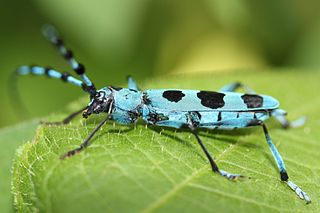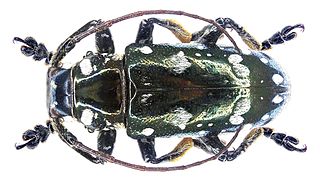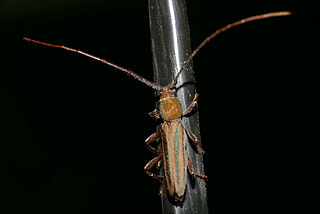
The Prioninae are a subfamily of Cerambycidae. They are typically large (25–70 mm) and usually brown or black. The males of a few genera sport large mandibles that are used in fights with other males, similar to stag beetles. These beetles are commonly nocturnal and are attracted to light. The majority of the Prioninae whose biology is known are borers whose larvae feed on rotting wood or roots.

Lamiinae, commonly called flat-faced longhorns, are a subfamily of the longhorn beetle family (Cerambycidae). The subfamily includes over 750 genera, rivaled in diversity within the family only by the subfamily Cerambycinae.

Cerambycini is a tribe of longhorn beetles classified under the subfamily Cerambycinae.
Acanthocinini is a tribe of longhorn beetles of the subfamily Lamiinae. It was described by Blanchard in 1845.

Callichromatini is a tribe of beetles in the subfamily Cerambycinae, which includes the following genera:

Callidiopini is a tribe of longhorn beetles in the subfamily Cerambycinae.

Clytini is a tribe of beetles in the subfamily Cerambycinae, containing the following genera:

Compsocerini is a tribe of beetles in the subfamily Cerambycinae, containing the following genera:

Elaphidiini is a tribe of beetles in the subfamily Cerambycinae, historically also often spelled "Elaphidionini".

Ibidionini is a tribe of beetles in the subfamily Cerambycinae.

Obriini is a tribe of beetles in the subfamily Cerambycinae

Xystrocera is a genus of beetles in the subfamily Cerambycinae and the tribe Xystrocerini, with a relatively world-wide distribution.

Apomecynini is a tribe of longhorn beetles of the subfamily Lamiinae.

Desmiphorini is a tribe of longhorn beetles of the subfamily Lamiinae.

Pteropliini is a tribe of longhorn beetles of the subfamily Lamiinae.

Saperdini is a tribe of longhorn beetles of the subfamily Lamiinae.

Lamiini is a tribe of longhorn beetles of the subfamily Lamiinae.
Tragocephalini is a tribe of longhorn beetles of the subfamily Lamiinae. It was described by James Thomson in 1857.

Rhytiphora is a genus of flat-faced longhorn beetles in the Pteropliini tribe of the subfamily Lamiinae. The genus was first described in 1835 by Jean Guillaume Audinet-Serville.

Xystrocerini is a tribe of longhorn beetles in the subfamily Cerambycinae, erected by Blanchard in 1845.


















